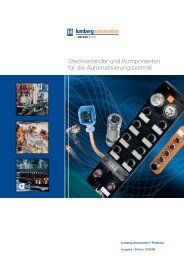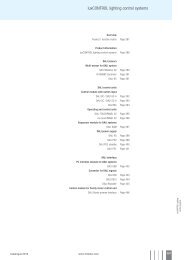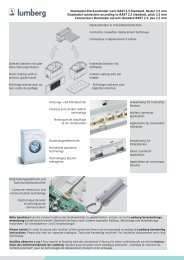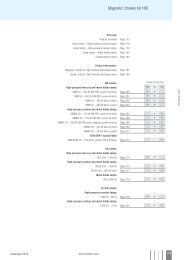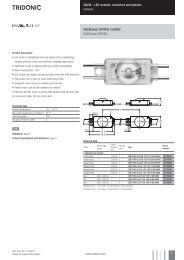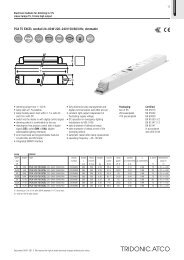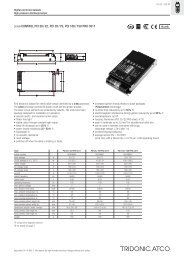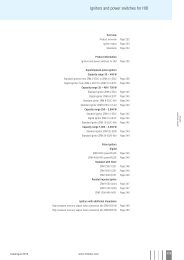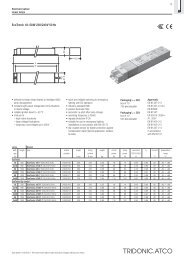Create successful ePaper yourself
Turn your PDF publications into a flip-book with our unique Google optimized e-Paper software.
<strong>T5</strong> linear lamps<br />
Low profile emergency lighting modules<br />
Linear <strong>T5</strong> lamps<br />
<strong>EM</strong> <strong>T5</strong> <strong>BASIC</strong> 220–240 V <strong>50</strong>/<strong>60</strong> <strong>Hz</strong><br />
RoHS<br />
21 mm<br />
4<br />
30<br />
21<br />
280<br />
270<br />
Description:<br />
Low profile emergency lighting modules to cover<br />
1 hour and 3 hour duration operating from NiCd<br />
and NiMh batteries. All modules incorporate five<br />
pole technology for use with HF ballasts and have<br />
permanent cathode heating during the emergency<br />
operation.<br />
Features:<br />
Module<br />
• Low profile section (21 mm x 30 mm)<br />
• 5 pole technology<br />
• For use with HF ballasts<br />
• NiCd and NiMh batteries<br />
• 24 hour accu recharge time<br />
• 3 hour and 1 hour operation<br />
• AC operation of lamps<br />
• Permanent cathode heating during<br />
emergency operation<br />
• Deep discharge protection<br />
• Regulated electronic charging circuit<br />
• Rest mode facility<br />
Batteries<br />
• NiCd and NiMh<br />
• D or Cs cells<br />
• High temperature cells<br />
• Spade terminals for easy connection<br />
Certified<br />
• EN 5<strong>50</strong>15: 2006 + A1: 2007<br />
• EN <strong>60</strong>1347-2-7<br />
• EN <strong>60</strong>925<br />
• EN 61000-3-2<br />
• Allows compliance with EN <strong>60</strong>598-2-22<br />
• EN 61547<br />
• IEC <strong>60</strong>068-2-6<br />
• IEC <strong>60</strong>068-2-29<br />
• IEC <strong>60</strong>068-2-30<br />
Type article number duration (hours) battery (cells) battery type<br />
<strong>EM</strong> 14/24-4 <strong>T5</strong> <strong>BASIC</strong> 89899822 1 + 3 4 for 3 hours duration:<br />
<strong>EM</strong>21/28/49-5 <strong>T5</strong> <strong>BASIC</strong> 89899823 1 + 3 5 4 Ah D size NiCd<br />
<strong>EM</strong> 39-5 <strong>T5</strong> <strong>BASIC</strong> 89899824 1 + 3 5 for 1 hour duration:<br />
<strong>EM</strong> 35-6 <strong>T5</strong> <strong>BASIC</strong> 89899825 1 + 3 6 1.5 Ah Cs size NiCd or<br />
<strong>EM</strong> 54/80-6 <strong>T5</strong> <strong>BASIC</strong> 89899826 1 + 3 6 2.0 Ah Cs size NiMh<br />
type<br />
article number<br />
LED <strong>EM</strong> green 89899<strong>60</strong>5<br />
LED <strong>EM</strong> Green UHB 89899756<br />
type<br />
article number<br />
test switch <strong>EM</strong> 2 89805277<br />
Jumper selection:<br />
3 hours operation as supplied for use with 4 Ah D cells.<br />
Remove the jumper for 1 hour operation and use with Cs<br />
1.5 Ah NiCd or 2.0 Ah NiMh cells.<br />
Battery packs article type cells<br />
NiCd 1.5 Ah Cs cells number<br />
Accu-NiCd C 4A 89899692 stick 4<br />
Accu-NiCd C 4B 89899693 side by side 4<br />
Accu-NiCd C 4C 89899694 stick+stick 2+2<br />
Accu-NiCd C 5A 89899695 stick 5<br />
Accu-NiCd C 5B 89899696 side by side 5<br />
Accu-NiCd C 5C 89899697 stick+stick 3+2<br />
Accu-Nicd C 6A 89899698 stick 6<br />
Accu-NiCd C 6C 89899699 stick+stick 3+3<br />
Battery packs article type cells<br />
NiCd 4.0 Ah D cells number<br />
Accu-NiCd 4A 89895961 stick 4<br />
Accu-NiCd 4B 89895977 side by side 4<br />
Accu-NiCd 4C 89895978 stick+stick 2+2<br />
Accu-NiCd 5A 89895973 stick 5<br />
Accu-NiCd 5B 89895962 stick+stick 3+2<br />
Accu-NiCd 6A 89895963 stick+stick 3+3<br />
Battery packs article type cells<br />
NiMh 2.0 Ah Cs cells number<br />
Accu-NiMh C 4A 89899700 stick 4<br />
Accu-NiMh C 4B 89899701 side by side 4<br />
Accu-NiMh C 4C 89899702 stick+stick 2+2<br />
Accu-NiMh C 5A 89899703 stick 5<br />
Accu-NiMh C 5B 89899704 side by side 5<br />
Accu-NiMh C 5C 89899705 stick+stick 3+2<br />
Accu-NiMh C 6A 89899706 stick 6<br />
Accu-NiMh C 6C 89899707 stick+stick 3+3<br />
Data sheet 03/07-640-0 We reserve the right to make technical changes without prior notice.
Low profile emergency lighting modules<br />
Linear <strong>T5</strong> lamps<br />
Technical data:<br />
<strong>EM</strong> <strong>T5</strong> <strong>BASIC</strong> 3 hour 1 hour<br />
Rated mains supply voltage 220–240 V 220–240 V<br />
Mains frequency <strong>50</strong>/<strong>60</strong> <strong>Hz</strong> <strong>50</strong>/<strong>60</strong> <strong>Hz</strong><br />
Mains supply current 35 mA max 25 mA max<br />
Mains supply power < 7 W < 7 W<br />
Overvoltage protection 320 V for 1 hour 320 V for 1 hour<br />
Max. working voltage U-OUT of the used ballast 4<strong>60</strong> V 4<strong>60</strong> V<br />
Recharge period 24 hours 24 hours<br />
Discharge current 1.1 A 1.1 A<br />
Charge current NiCd/NiMh 200 mA 100 mA<br />
Earth leakage current < 0.5 mA < 0.5 mA<br />
Ambient temperature range +5 °C to +<strong>60</strong> °C +5 °C to +<strong>60</strong> °C<br />
Maximum case temperature tc 70 °C 70 °C<br />
Mains change over voltage in accordance with EN <strong>60</strong>598-2-22 in accordance with EN <strong>60</strong>598-2-22<br />
Min. lamp starting temperature (emergency mode) +5 °C +5 °C<br />
Ingress protection IP20 IP20<br />
Safety class class I class I<br />
Ballast compatibility<br />
The <strong>EM</strong> <strong>T5</strong> <strong>BASIC</strong> emergency units use 5 pole technology and are compatible<br />
with most high frequency ballasts on the market, however it is important to<br />
check that the U-OUT rating of the ballast does not exceed the value specified<br />
under “Technical data”.<br />
Emergency light output factors (BLF) in %<br />
Type wattage BLF<br />
W %<br />
<strong>EM</strong> 14/24-4 <strong>T5</strong> <strong>BASIC</strong> 14 21<br />
<strong>EM</strong> 21/28/49-5 <strong>T5</strong> <strong>BASIC</strong> 21 12<br />
<strong>EM</strong> 21/28/49-5 <strong>T5</strong> <strong>BASIC</strong> 28 12<br />
<strong>EM</strong> 35-6 <strong>T5</strong> <strong>BASIC</strong> 35 13<br />
<strong>EM</strong> 14/24-4 <strong>T5</strong> <strong>BASIC</strong> 24 14<br />
<strong>EM</strong> 39-5 <strong>T5</strong> <strong>BASIC</strong> 39 7<br />
<strong>EM</strong> 21/28/49-5 <strong>T5</strong> <strong>BASIC</strong> 49 7<br />
<strong>EM</strong> 54/80-6 <strong>T5</strong> <strong>BASIC</strong> 54 6.5<br />
<strong>EM</strong> 54/80-6 <strong>T5</strong> <strong>BASIC</strong> 80 4.5<br />
Accu-NiCd<br />
case temperature range 0 °C to +55 °C<br />
to ensure 4 years design life<br />
storage life in temperate conditions 4 years<br />
battery voltage/cell<br />
1.2 V<br />
capacity D<br />
4.0 Ah<br />
capacity Cs<br />
1.5 Ah<br />
Accu-NiMh<br />
case temperature range 0 °C to +55 °C<br />
to ensure 4 years design life<br />
storage life in temperate conditions 4 years<br />
battery voltage<br />
1.2 V<br />
capacity Cs<br />
2.0 Ah<br />
Test switch:<br />
An optional test switch can be wired to the <strong>EM</strong> <strong>T5</strong> Basic.<br />
This can be used to check local operation of the luminaire.<br />
Status indication<br />
A green LED indicates charge current is flowing to the battery.<br />
Service life:<br />
Average service life <strong>50</strong>,000 hours under rated conditions with a<br />
failure rate of less than 10%. Average failure rate of 0.2% per<br />
1000 operating hours.<br />
2<br />
Data sheet 03/07-640-0 We reserve the right to make technical changes without prior notice.
Low profile emergency lighting modules<br />
Linear <strong>T5</strong> lamps<br />
Mechanical details:<br />
Channel manufactured from galvanised steel.<br />
Cover manufactured from white pre-coated steel.<br />
LED status indicator<br />
• Green<br />
• Mounting hole 6.5 mm dia<br />
• Lead length 1000 mm<br />
Test switch<br />
• Mounting hole 7.0 mm dia<br />
• Lead length 5<strong>50</strong> mm<br />
Battery leads<br />
• Quantity: 1 red and 1 black<br />
• Length: 1300 mm<br />
• Wire type: 0.5 mm 2 solid conductor<br />
• Insulation rating: 90 °C<br />
Battery end termination<br />
Push on 4.8 mm receptacle to suit battery<br />
spade fitted with insulating cover<br />
Module end termination<br />
8.0 mm stripped insulation<br />
Two-piece batteries are supplied with a 200 mm<br />
lead with 4.8 mm receptacle at each end and<br />
insulting covers to connect the separate sticks<br />
together.<br />
Electrical connections:<br />
An earthed starting aid is recommended. The<br />
module should be earthed by the fixings used to<br />
attach it to the luminaire.<br />
Wiring:<br />
Lamp/ballast/supply<br />
wire preparation:<br />
0.5–0.75<br />
8–9 mm<br />
Loosen wire through<br />
twisting and pulling<br />
Batteries:<br />
Connection method: 4.8 x 0.5 mm spade tag<br />
welded to end of cell<br />
For stick packs this connection is accessible<br />
after the battery caps have been fitted.<br />
To inhibit inverter operation disconnect the<br />
batteries by removing the connector from the<br />
battery spade tag.<br />
For battery data see separate data sheet.<br />
IDC interface<br />
• solid wire with a cross section of 0.5 mm²<br />
according to the specification from WAGO<br />
• alternatively a flexible lead with a cross section<br />
of 0.75 mm²<br />
Horizontal interface<br />
• solid wire with a cross section of 0.5–0.75 mm²<br />
according to the specification from WAGO<br />
• solid wire with a cross section of 1.0 mm² with<br />
an insulation diameter up to 2.5 mm<br />
• strip 9 mm of insulation from the cables<br />
• Loosen wire through twisting and pulling<br />
Batteries/LED/Test switch<br />
push terminal with button release: 0.5 mm²<br />
6.5 mm strip<br />
Maximum lamp lead capacitance<br />
terminals 5 and 6 (* hot leads) 100 pF 1)<br />
terminals 3 and 4 200 pF 1)<br />
1)<br />
Note: care should be taken not to exceed the total maximum<br />
lamp lead capacitance for HF ballast. Leads should always be<br />
kept as short as possible.<br />
Packing quantities:<br />
<strong>EM</strong> <strong>T5</strong> <strong>BASIC</strong>: 25 units per carton<br />
LED:<br />
25 pieces per box<br />
Accu-NiCd: 25 pieces per box<br />
Accu-NiMh: 25 pieces per box<br />
Wiring guidelines<br />
To ensure that a luminaire containing high frequency<br />
emergency units complies with EN 5<strong>50</strong>15 for radio<br />
frequency conducted interference in both normal and<br />
emergency mode it is essential to follow good practice<br />
in the wiring layout.<br />
Within the luminaire the switched and unswitched <strong>50</strong><br />
<strong>Hz</strong> supply wiring must be routed as short as possible<br />
and be kept as far away as possible from the lamp<br />
leads.<br />
This means, for example, in a linear T8 or <strong>T5</strong> luminaire<br />
the mains wiring should be routed along one side of<br />
the luminaire body, while the wires to the emergency<br />
lamp from the emergency module are routed along the<br />
other side.<br />
The high frequency emergency lamp wiring contains<br />
“hot” leads at pins 1 and 6, which have high voltage to<br />
earth. These should be kept as short as possible and<br />
separated from other wiring to minimize coupling.<br />
They also have a restriction on capacitance to other<br />
wiring and earth of 100 pF, which must be observed to<br />
ensure good lamp starting.<br />
With an earth connection of the metal case of the<br />
emergency module the noise suppression can be further<br />
improved. The wiring of the earth should be kept<br />
as short as possible.<br />
Through wiring may affect the emc performance of the<br />
luminaire.<br />
With the use of the fifth pole possible compatibility<br />
problems between the products can be prevented.<br />
Depending on the luminaire wiring the radio<br />
suppres-sion in the emergency mode of operation can<br />
be further improved.<br />
Capacitive loading limits of lamp leads must not be<br />
exceeded. Note the capacitance of the emergency<br />
lamp leads adds to the capacitance of the leads from<br />
the ballast to the <strong>EM</strong> <strong>BASIC</strong> module when considering<br />
ballast loading.<br />
Data sheet 03/07-640-0 We reserve the right to make technical changes without prior notice.<br />
3
Low profile emergency lighting modules<br />
Linear <strong>T5</strong> lamps<br />
<strong>EM</strong> <strong>T5</strong> <strong>BASIC</strong> emergency module wiring diagrams<br />
Not for use with magnetic ballasts and switch start circuits<br />
Switched line out to ballast<br />
Line in from switch<br />
Neutral<br />
Rest positive<br />
Rest negative<br />
Permanent line<br />
Lout<br />
Lin<br />
N<br />
Rest<br />
Rest<br />
L<br />
+<br />
LED<br />
LED<br />
–<br />
Switch<br />
<strong>EM</strong> <strong>T5</strong> <strong>BASIC</strong><br />
<strong>EM</strong>ERGENCY MODULE<br />
8<br />
7<br />
6<br />
5<br />
4<br />
3<br />
2<br />
1<br />
Emergency lamp<br />
Switched line out to ballast<br />
Line in from switch<br />
Neutral<br />
Rest positive<br />
Rest negative<br />
Permanent line<br />
Lout<br />
Lin<br />
N<br />
Rest<br />
Rest<br />
L<br />
+<br />
LED<br />
LED<br />
–<br />
Switch<br />
<strong>EM</strong> <strong>T5</strong> <strong>BASIC</strong><br />
<strong>EM</strong>ERGENCY MODULE<br />
8<br />
7<br />
6<br />
5<br />
4<br />
3<br />
2<br />
1<br />
Emergency lamp<br />
Optional<br />
Test<br />
Switch<br />
orange (+)<br />
LED<br />
pink (–)<br />
Battery<br />
Optional<br />
Test<br />
Switch<br />
orange (+)<br />
LED<br />
pink (–)<br />
Battery<br />
Neutral to ballast<br />
Neutral to ballast<br />
HF BALLAST<br />
U-OUT max. 4<strong>60</strong> V<br />
HF BALLAST<br />
U-OUT max. 4<strong>60</strong> V<br />
* Hot leads<br />
* Hot leads<br />
Lamp<br />
Wiring diagram for single lamp high frequency ballasts<br />
Wiring diagram for twin lamp high frequency ballasts with 6 terminals<br />
Switched line out to ballast<br />
Line in from switch<br />
Neutral<br />
Rest positive<br />
Rest negative<br />
Permanent line<br />
Lout<br />
Lin<br />
N<br />
Rest<br />
Rest<br />
L<br />
+<br />
LED<br />
LED<br />
–<br />
Switch<br />
<strong>EM</strong> <strong>T5</strong> <strong>BASIC</strong><br />
<strong>EM</strong>ERGENCY MODULE<br />
8<br />
7<br />
6<br />
5<br />
4<br />
3<br />
2<br />
1<br />
Emergency lamp<br />
Switched line out to ballast<br />
Line in from switch<br />
Neutral<br />
Rest positive<br />
Rest negative<br />
Permanent line<br />
Lout<br />
Lin<br />
N<br />
Rest<br />
Rest<br />
L<br />
+<br />
LED<br />
LED<br />
–<br />
Switch<br />
<strong>EM</strong> <strong>T5</strong> <strong>BASIC</strong><br />
<strong>EM</strong>ERGENCY MODULE<br />
8<br />
7<br />
6<br />
5<br />
4<br />
3<br />
2<br />
1<br />
Emergency lamp<br />
Optional<br />
Test<br />
Switch<br />
orange (+)<br />
LED<br />
pink (–)<br />
Battery<br />
Optional<br />
Test<br />
Switch<br />
orange (+)<br />
LED<br />
pink (–)<br />
Battery<br />
Neutral to ballast<br />
Neutral to ballast<br />
HF BALLAST<br />
U-OUT max. 4<strong>60</strong> V<br />
HF BALLAST<br />
U-OUT max. 4<strong>60</strong> V<br />
Lamp<br />
Lamp<br />
* Hot leads<br />
* Hot leads<br />
Wiring diagram for twin lamp high frequency ballasts with 7 terminals<br />
Wiring diagram for twin lamp high frequency ballasts with 8 terminals<br />
No connection to be made<br />
Neutral<br />
Rest positive<br />
Rest negative<br />
Permanent line<br />
Optional<br />
Test<br />
Switch<br />
Lout<br />
Lin<br />
N<br />
Rest<br />
Rest<br />
L<br />
+<br />
LED<br />
LED<br />
–<br />
Switch<br />
orange (+)<br />
LED<br />
pink (–)<br />
<strong>EM</strong> <strong>T5</strong> <strong>BASIC</strong><br />
<strong>EM</strong>ERGENCY MODULE<br />
Batteries<br />
8<br />
7<br />
6<br />
5<br />
4<br />
3<br />
2<br />
1<br />
* Hot leads<br />
Emergency lamp<br />
Wiring diagram for non-maintained operation<br />
Note: All hot leads normally marked with an * should be kept as short as possible. For comprehensive wiring diagrams and instructions consult the TridonicAtco website www.tridonicatco.com<br />
Data sheet 03/07-640-0 We reserve the right to make technical changes without prior notice.



